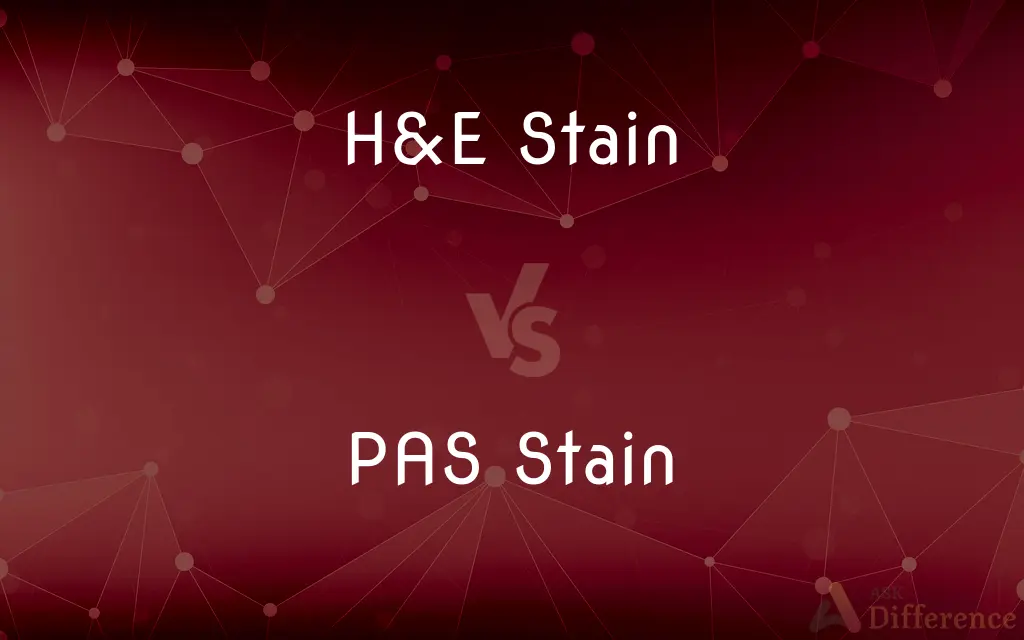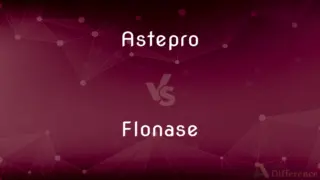H&E Stain vs. PAS Stain — What's the Difference?
By Fiza Rafique & Maham Liaqat — Published on February 27, 2024
H&E stain is the most common technique for general tissue structure visualization, highlighting cell nuclei and cytoplasmic components. While PAS stain, detects polysaccharides, mucosubstances, and glycoproteins in tissues.

Difference Between H&E Stain and PAS Stain
Table of Contents
ADVERTISEMENT
Key Differences
Hematoxylin and Eosin (H&E) staining is a fundamental technique in histology and pathology, providing a broad overview of tissue architecture and morphology. Hematoxylin stains cell nuclei blue, delineating them clearly against the pink cytoplasmic and extracellular matrix background stained by eosin. This dual staining offers a contrast that is invaluable for examining cell and tissue structure, enabling the identification of various cell types and the overall layout of tissue specimens.
The Periodic Acid-Schiff (PAS) stain, on the other hand, is specialized for identifying structures rich in carbohydrates. By oxidizing polysaccharides to aldehydes, which then react with Schiff's reagent to produce a magenta color, PAS staining highlights components like glycogen, mucins, and basement membranes. This makes it particularly useful for diagnosing diseases where these elements are involved, such as glycogen storage diseases, certain fungal infections, and components of the extracellular matrix.
H&E is essential for general histopathological assessment, providing a quick and comprehensive view of tissue health and basic structures, whie PAS offers more specialized insights. It is especially valuable in highlighting details that are not readily apparent with H&E, such as the basement membrane in kidney biopsies, which is crucial for diagnosing conditions like Alport syndrome or diagnosing fungal infections where the cell wall components are visualized.
The choice between H&E and PAS staining depends on the diagnostic needs. H&E is suitable for routine examination and is often the first step in tissue analysis. If further detail on carbohydrate structures is required, or if there is a need to highlight specific components like fungi or basement membranes, PAS staining is employed. In many diagnostic processes, both staining methods may be used in sequence to provide a comprehensive understanding of the tissue pathology.
Comparison Chart
Primary Use
General tissue morphology
Carbohydrate-rich structures
ADVERTISEMENT
Coloration
Nuclei blue, cytoplasm pink
Polysaccharides and mucins magenta
Key Components Identified
Cell nuclei and basic tissue structure
Glycogen, mucosubstances, basement membranes
Diagnostic Value
Broad overview of tissue health and morphology
Detailed visualization of carbohydrate structures
Application
Routine histopathological examination
Specific diseases involving glycogen, mucins, and fungal infections
Compare with Definitions
H&E Stain
Essential for routine histopathological examination.
Every tissue sample received in the lab is first examined with H&E stain.
PAS Stain
Used to visualize glycogen, mucins, and basement membranes.
The liver biopsy, PAS-stained, showed abnormal glycogen accumulation.
H&E Stain
Highlights cell nuclei in blue and cytoplasm in pink.
The pathologist noted the clear distinction between nuclei and cytoplasm in the H&E-stained slide.
PAS Stain
Highlights fungal cell walls in infections.
PAS staining made the fungal hyphae in the tissue sample readily apparent.
H&E Stain
A basic staining technique for visualizing general tissue structure.
H&E stain was used to assess the biopsy, revealing normal tissue architecture.
PAS Stain
Essential for diagnosing glycogen storage diseases.
PAS stain confirmed the diagnosis of a glycogen storage disease in the patient.
H&E Stain
Provides a comprehensive view of tissue health.
The H&E stain revealed signs of inflammation, suggesting an underlying condition.
PAS Stain
Can be used to detail components of the extracellular matrix.
The integrity of the basement membrane was assessed using PAS staining in the research study.
H&E Stain
Enables identification of various cell types.
Differentiating between epithelial and connective tissue was facilitated by H&E staining.
PAS Stain
Specialized staining for carbohydrate-rich structures.
PAS stain highlighted the basement membrane thickening in the kidney biopsy.
Common Curiosities
What makes PAS stain specific for carbohydrates?
PAS stain relies on the oxidation of polysaccharides to aldehydes, which then react with Schiff's reagent, specifically highlighting carbohydrate-rich structures.
How do pathologists choose between H&E and PAS staining?
The choice is based on the initial histopathological findings with H&E; if further detail on glycogen, mucins, or basement membranes is needed, PAS staining is employed.
Why is H&E stain so widely used in histology?
Its ability to provide a clear, general overview of tissue structure and cell morphology makes it indispensable for routine histopathological examination.
Are there tissues that are better visualized with PAS than with H&E?
Tissues with significant carbohydrate components, such as the kidney's glomerular basement membrane or liver tissue in glycogen storage diseases, are better visualized with PAS.
What are the limitations of H&E staining?
While versatile, it may not provide sufficient detail for diagnosing diseases that affect specific types of tissue components, like carbohydrates, requiring more specialized stains like PAS.
How does tissue preparation for H&E compare to PAS staining?
Tissue preparation for both stains involves formalin fixation and paraffin embedding, but PAS staining includes an additional oxidation step before applying Schiff's reagent.
Can Nutrient Agar support the growth of fungi and yeasts?
Yes, Nutrient Agar can support the growth of a wide range of microorganisms, including some fungi and yeasts, due to its non-selective nutrient composition.
Is PAS staining useful for identifying all types of fungi?
Yes, because it stains the polysaccharides in fungal cell walls, making it broadly effective for visualizing a variety of fungal species.
Can H&E and PAS stains be used together?
Yes, they are often used sequentially on different sections of the same tissue to provide a comprehensive view of tissue morphology and specific carbohydrate structures.
Can PAS stain detect all diseases related to glycogen storage?
PAS is highly effective for highlighting glycogen in tissues, making it valuable for diagnosing many glycogen storage diseases, though clinical correlation is always necessary.
Is Mueller Hinton Agar only used for the Kirby-Bauer disk diffusion method?
While it is the standard medium for the Kirby-Bauer disk diffusion method, Mueller Hinton Agar can also be used in other susceptibility testing methods and for culturing non-fastidious bacteria.
Why is controlled pH important in Mueller Hinton Agar for antibiotic testing?
A controlled pH ensures that the antibiotics' activity is consistent and predictable, as fluctuations in pH can affect the potency and diffusion rates of antibiotics across the agar.
What is the significance of the magenta color in PAS staining?
The magenta color indicates the presence of polysaccharides and mucosubstances, providing crucial diagnostic information about the tissue's carbohydrate content.
How does the presence of starch in Mueller Hinton Agar influence antibiotic susceptibility testing?
The starch in Mueller Hinton Agar absorbs toxins released by bacteria, neutralizing factors that might otherwise inhibit the action of antibiotics, thus ensuring more accurate testing results.
How does the inclusion of beef extract and peptone in Nutrient Agar affect microbial growth?
Beef extract and peptone provide a rich source of amino acids, peptides, and vitamins, which are essential nutrients that support the growth of a broad spectrum of microorganisms. about the tissue's carbohydrate content.
Share Your Discovery

Previous Comparison
Astepro vs. Flonase
Next Comparison
Beige vs. KhakiAuthor Spotlight
Written by
Fiza RafiqueFiza Rafique is a skilled content writer at AskDifference.com, where she meticulously refines and enhances written pieces. Drawing from her vast editorial expertise, Fiza ensures clarity, accuracy, and precision in every article. Passionate about language, she continually seeks to elevate the quality of content for readers worldwide.
Co-written by
Maham Liaqat















































